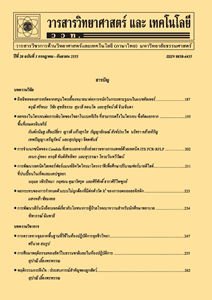การหาลักษณะเฉพาะของซิลิกาบริสุทธิ์จากแกลบที่ผ่านการปรับปรุงสมบัติด้วยกรด
Main Article Content
Abstract
บทคัดย่อ
งานวิจัยนี้ได้ศึกษาผลของการปรับปรุงสมบัติด้วยกรดและการเผาแคลไซน์ต่อเปอร์เซ็นต์ซิลิกา เฟส ความขาว พื้นที่ผิว และปริมาตรรูพรุนของเถ้าแกลบ สมบัติของเถ้าแกลบดีขึ้นเมื่อแกลบได้ผ่านการปรับปรุงสมบัติด้วยกรด ผลวิเคราะห์ด้วยเทคนิค TG/DTA แสดงอุณหภูมิการเผาแคลไซน์แกลบดิบต้องสูงกว่า 600 °C ผลวิเคราะห์เทคนิค XRD และ XRF แสดงให้เห็นว่าเถ้าแกลบที่ผ่านการปรับปรุงสมบัติด้วยกรดและตามด้วยการเผาแคลไซน์ที่ 700-900 °C มีสีขาว มีซิลิกาที่เป็นเฟสอสัณฐาณปริมาณสูง ผลวิเคราะห์ด้วยเทคนิค BET พบว่าแกลบที่ผ่านการปรับปรุงสมบัติด้วยกรดมีพื้นที่ผิวและปริมาณรูพรุนสูง สำหรับแกลบที่ไม่ได้ผ่านการปรับปรุงสมบัติด้วยกรดเมื่อผ่านการเผาแคลไซน์ที่อุณหภูมิ 900 °C พบการเปลี่ยนเฟสอสัณฐานเป็นคริสโตบาไลต์
คำสำคัญ : แกลบดิบ; เถ้าแกลบ; การปรับปรุงสมบัติด้วยกรด; ซิลิกา
Abstract
In this study, the effects of acid treatment and calcinations of rice husk ash on percentage of silica, phase, whiteness, surface area and pore volume have been investigated. Pretreatment of rice husk with acid improved the properties of ash. TG/DTA results indicated that the calcination temperature of rice husk should be above 600 °C. X-ray diffraction (XRD) and X-ray fluorescence (XRF) results showed that white rice husk ash containing large amount of amorphous silica was obtained by acid treatment and calcinations at 700-900 °C. BET results showed that higher surface area and pore volume were also obtained in acid treated samples. The transition from amorphous silica to cristobalite after calcinations at 900 °C was observed in untreated samples.
Keywords: rice husk; rice husk ash; acid treatment; silica


